March – Bittercresses for Beginners
January – Ivies
Clare Coleman
The WFS diary lists the familiar common ivy, Hedera helix but ivies are more interesting than you would think! There are in fact two subspecies of the H. helix and at least two other alien ivies which have become naturalised in Britain.
Identifying alien (i.e. non-native to the British Isles) plants can be tricky as few are illustrated in the usual field guides. However, the Plant Crib on p 216 – 218 has excellent tips on Hedera with some drawings of leaf shapes. Stem hairs are also important distinguishing features of ivies, so a hand lens is recommended.
H. colchica (Persian Ivy) is an established garden escape and can be locally abundant. It originates from Eastern Europe and Turkey. There is a well known site on Weybridge Common, Surrey. It has large (10cm +), leathery dark green cordate (heart shaped) leaves. The stem hairs are golden brown whereas those on H. helix are white.
H. helix subsp. canariensis or H. algeriensis (Algerian Ivy) is less common than H. colchica. It also has large leaves but the leaf bases are rounded rather than cordate (see p 989, figures C & D in Stace for an illustration of these different leaf bases) and is more glossy than H. colchica. Both the above Hedera have semi-peltate (basin-shaped) stem hairs whereas the next two species both have stellate (star-shaped) hairs.
H. helix subsp. helix (Common Ivy) and H. helix subsp. hibernica (Atlantic Ivy) are tricky to distinguish. Always use young stems when looking at the hairs to distinguish these species and look for the following characteristics:
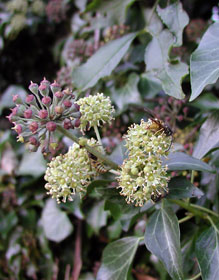
| Character | H. helix subsp. helix | H. helix subsp. hibernica |
|---|---|---|
| Leaves | < 8 cm | > 8 cm |
| Hairs on leaves | Grey white rays of hairs projecting in all directions | Yellow and lying parallel to the leaf surface |
| Stem | densely hairy | Downy |
| Habitat | Needs base-rich soils and does not tolerate acid soil | Tolerates wide range of soils; more common in the west of the UK; can colonise unstable rock and storm beaches |
| Sap | strong sweet odour | weak, bitter odour |
Fortunately there is no reported hybridization amongst ivies.
Further reading and references
The BSBI handbook on aliens plants by E Clement and C Foster contains useful references on where to find species illustrations.
Rose, PQ (1980) Ivies
Stace, CA (1975) Hybridization and the Flora of the British Isles
Stace, CA (1997) New Flora of the British Isles
Rich, T & Jermy, AC (1998) Plant Crib
February – Celandines
Clare Coleman and Peter Llewellyn
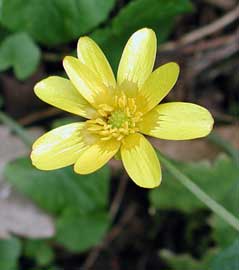
Often flowering as early as December the year before Spring, the buttery yellow stars of Lesser Celandine, Ficaria verna (old name Ranunculus ficaria) in shady hedgebanks are a welcome hint of Spring. The usual flowering time is March and April but as the climate has warmed early reports of flowers e.g. November have become more frequent.
These flowers are easily recognised yet are in fact very variable – celandines usually have eight petals but six or ten are not uncommon. A double-flowered form was first found by John Ray as early as 1665. Celandines also play games with their leaf size and shape.
In the 2010 third edition of New Flora of the British Isles by Professor Clive Stace, the systematic (Latin) names of Lesser Celandine were changed. The commonest sub species Ranunculus ficaria ssp. ficaria was not, as might have been assumed, changed to Ficaria verna ssp. verna but to Ficaria verna ssp. fertilis. Ficaria verna ssp verna is the sub species with small bulbils in the leaf axils previously known as Ficaria verna ssp. bulbilifer. The right hand photo shows the very small bulbils of Ficaria verna ssp. verna in the leaf axils which take a bit of finding as they are rarely to be seen as you look directly down on the plants. The bulbils are hard to find and the flowers and leaves look much the same as Ficaria verna ssp. fertilis so this plant is probably under recorded. Ficaria verna ssp. ficariiformis also has bulbils but is very rare.
There are four subspecies but the two subspecies Ficaria verna ssp. ficariiformis (Ranunculus ficaria ssp. ficariiformis) and Ficaria verna ssp. chrysocephalus (Ranunculus ficaria ssp. chrysocephalus) both with larger leaves (> 4 cm) and petals (up to 6 cm in diameter) are relatively rare. Flower size needs to be observed on early visits as the flowers later in the season tend to be smaller. The table below sets out the key features to look for to identify celandines:
The celandine’s other common name is pilewort – a name originating from the ‘Doctrine of Signatures’ in medieval Britain which prescribed cures according to physical resemblance of herbs to parts of the body – the celandine’s tubers are said to resemble piles therefore the plant was used as a cure for this particular ailment! Celandines are also reputed to have magical properties – if picked on the morning of St. Peter’s day (29th June), the plant would give protection from imprisonment.
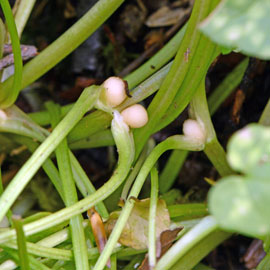
| New Name: | Ficaria verna ssp. fertilis | Ficaria verna ssp. verna | Ficaria verna ssp. ficariiformis | Ficaria verna ssp. chrysocephalus |
|---|---|---|---|---|
| Old name: | Ranunculus ficaria ssp. ficaria | Ranunculus ficaria ssp. bulbilifer | Ranunculus ficaria ssp. ficariiformis | Ranunculus ficaria ssp. chrysocephalus |
| Leaf (diameter) | < 4 cm | < 4 cm | > 4 cm | > 4 cm |
| Flower (diameter) | Up to 4 cm | Up to 4 cm | Up to 6 cm | Up to 6 cm |
| Stems | N/A | N/A | Procumbent and trailing | More or less erect |
| Bulbils | None | Present after flowering | Present after flowering | None |
| Achenes | Well developed | Not well developed | N/A | N/A |
Further reading and references: Sell, P D (1994) Watsonia 20 41-50
March – Bittercresses for Beginners – David Bevan
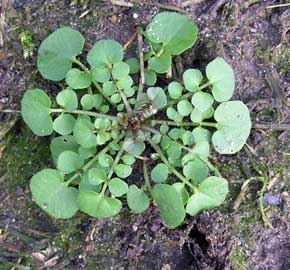
The bittercresses (Cardamine) can be a confusing group to get to know as several of them bear rather similar small white flowers. But each individual flower is very beautiful when examined under a hand lens! They are also some of the first plants to flower in the spring and they include some handsome garden relatives.
Bittercresses are in the cabbage (or cress) family which was, until recently, known as the Cruciferae. This useful name is derived from the Latin word “crux”, meaning a cross, and refers to the “cross-shaped” arrangement of the four petals in each flower. The family name now in favour is the rather less appealing Brassicaceae. The shape and size of the fruits is of critical importance in naming members of the cabbage family. In the bittercresses, the fruits (seed pods) are all long and thin. A useful feature of all bittercresses is that they generally have pinnate or ladder-like leaves with the side leaves (known as leaflets) on a distinct stalk (see photo opposite).
The three most common are lady’s-smock or cuckoo flower, hairy bittercress and wavy bittercress. Cardamine pratensis (Lady’s-smock) is a common plant of damp grassy places. It has comparatively large pink flowers (occasionally white) and yellow anthers. It is apparently resistant to some herbicides and can often be found growing on wet lawns — at Compton in Surrey sheets of lady’s-smock cover the (rather boggy) recreation pitch each spring. Pretty double flowered forms occur occasionally.
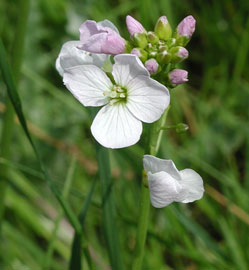
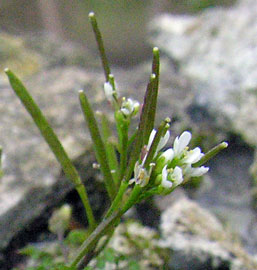
C. hirsuta (Hairy bittercress) and C. flexuosa (Wavy Bittercress) may look similar with small white flowers and a cress-like smell if you crush the leaves. The key difference to remember is that usually Hairy Bittercress is not very hairy (usually only along the leaf edges) and that it has 4 stamens. Wavy bittercress has 6 stamens. A way of remembering this is flex = sex (Latin for 6) = six. Careful though, the 2 outer stamens may be shorter and overlooked. Wavy bittercress normally prefers a damper habitat by streams and ditches whereas hairy bittercress usually grows in drier, weedy places and on wall tops. However, these habitat preferences are not absolute and wavy bittercress, for example, can sometimes be found in quite dry places. If touched when ripe, the pods curl up and spring open, scattering the seeds a considerable distance. Hence another common name for hairy bittercress is “popping cress”.
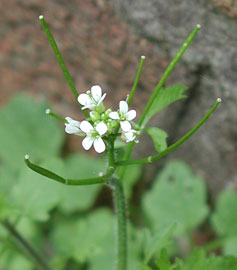
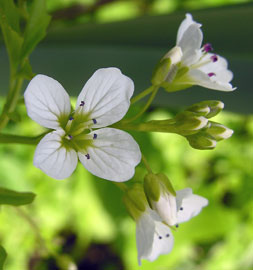
Two less common bittercresses are C. amara (large bittercress) and C. impatiens (Narrow-leaved Bittercress). Large Bittercress is similar to Lady’s-smock but usually has white flowers and always has violet anthers.
C. amara (Illustration 5) has a more restricted distribution and prefers wetter acid soils. Narrow-leaved bittercress has distinct auricles (pointed ear-like lobes at the base of the leaves – (see the illustration below Cardamine bulbifera opposite). It grows in woodland (especially under ash) in the Southeast and on limestone in North Somerset, Wales, the Peak District and the Pennines.
The rarest native bittercress is C. bulbifera (Coral-root). This plant has flowers about the same size as lady’s-smock but of a deeper shade of pink. The most striking feature however is the presence of small, rounded, purple-brown or black bulbils in the axils of many of the leaves. These are reproductive structures which can give rise to new plants. They are diagnostic of coral-root which grows in dry woods on chalk in the Chilterns and in wet woods on clay in a few places in the Weald.
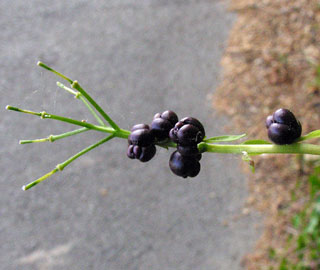
Bittercress hybrids
Bittercress hybrids are rare and often difficult to identify. However one rather striking example came to light at Bentley Priory in the West London borough of Harrow. The grassland here is cattle-grazed and particularly rich in wild flowers. There are extensive populations of both Lady’s-smock and Wavy Bittercress in the wetter areas. In April 1989, while taking a party of students to explore the flora, my eye was caught by a large patch of an unusual white-flowered bittercress growing under a willow tree in a damp hollow. A rather fierce-looking bullock prevented immediate closer examination and I was forced to return later. The flowers were pure white, produced very profusely and, with individual plants covering an area of some five square metres, they made a fine display. I suspected that they might have been hybrids as the flower size was intermediate between the larger ones of lady’s-smock and the tiny ones of wavy bittercress. However, flower size can be very variable in lady’s-smock and 1 was far from certain.
There was only one thing to do — talk to Tim Rich! Tim knows more about Crucifers than almost anybody, having written the splendid BSBI handbook on the family. Within a few days he was on site and “throwing down the gauntlet”! If the plants were indeed of hybrid origin, as he also now suspected, it should be possible to “recreate” them by deliberately cross-pollinating between neighbouring plants of the two suspected parents. I set about doing just that, cross pollinating between a whole range of different individual plants of Lady’s-smock and wavy bittercress. I then grew on resulting seeds.
To cut a very long story short, I ended up with four seedlings — all derived from crosses involving a white-flowered form of lady’s-smock. Three were eaten by slugs, but the fourth produced flowers identical to those of the original mystery plant. Honour had been satisfied and the hybrid origin of the Bentley Priory bittercress had been proved to Tim’s satisfaction! It was the first time it had been found in Middlesex. I stumbled on it again while recording for the Flora of Ashdown Forest – but that is another story!
The original text for this article was written for the Wild Flower Society’s magazine in 2003 by David Bevan. The new photographs and captions are by Peter Llewellyn Jan 2006.
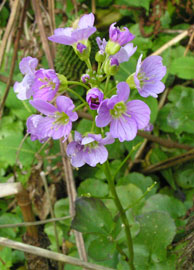
Cardamine raphanifolia (Greater Cuckoo Flower)
Not a hybrid but an unusual introduction from Southern Europe which looks a bit like a deep coloured Cardamine pratensis (Lady’s Smock or Cuckoo Flower). The leaves are different and it is only found scattered over Britain where it has escaped from cultivation.
April – Oaks – Clare Coleman
You need to be able to tell the two species of British Oak from one another in order to record either in your WFS diary. So which is which?
The problem for many beginners is that hybrids between English or Pendunculate Oak (Quercus robur) and Sessile Oak (Quercus petraea) are common – known as Quercus x rosacea. Beginners may feel rather overwhelmed by mention of plant hybrids. But it is the existence of hybrids that makes identification difficult. Generally, hybrids are intermediate in characters.
Quercus x rosacea often looks closer to Quercus robur, usually having a slightly lobed base to the leaf but has a leaf stalk, like Q. petraea
Oaks are a species that require you to look at a combination of characters to get a correct identification.
| Quercus robur | Quercus petraea | |
|---|---|---|
| Habitat | Wet Loams and clays | Lighter sandy soils |
| Acorns | Stalked | not stalked |
| Leaf stalk (or petiole) | None | Stalked |
| Hairs on underside of leaf | None | Stellate hairs along mid-rib |
| Base of leaf | Distinct lobed base known as auricles | Tapering base without auricles |
Further reading and references
To get an idea of what the hybrid Oak looks like, the illustrations on p75 of Plant Crib (1998) are excellent.
May – Bluebells – Clare Coleman and Peter Llewellyn
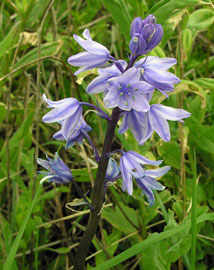
Bluebell woods are one of Britain’s loveliest sights. Although picking the flowers is now discouraged, research has shown that, in small amounts, this does not actually harm the plants. Instead, it is the trampling of the leaves, by an ever increasing number of visitors, that often kills the plants.
Bluebells are one of Britain’s most protected plants despite being relatively common. This is because Britain has about 30% of the total world population of Bluebells and there is a thriving illegal trade in wild bluebell bulbs. Even in Britain, it is still legal to take wild bluebell seed with the landowner’s consent, which is in high demand due to the popularity of ‘wildflower’ gardening. Perhaps it is time for a backlash against wildflower gardening as it inevitably puts pressure on wild populations.
Most plants grown in gardens are actually hybrids and the true Spanish Bluebell (Hyacinthoides hispanica) is therefore rarely naturalised. Recognising Spanish Bluebells or the hybrid between Spanish and wild Bluebells, H. x massartiana (formerly H. x variabilis) is important if wild populations are to be identified correctly and protected.
The table below sets out key characteristics to help distinguish the wild Bluebell from the hybrid and Spanish Bluebell. Hybrid Bluebells are fertile and at the extremes of the range cannot easily be distinguished from either parent. Researchers only distinguish native and non-native Bluebells.
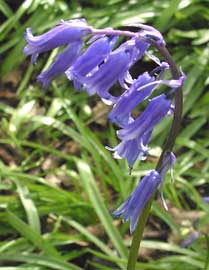
| Character | Hyacinthoides hispanica | Hyacinthoides x massartiana | Hyacinthoides non scripta |
|---|---|---|---|
| Leaf width | Often broad up to 25 mm but can be narrow 6 mm | Narrow and Broad 5 -45 mm | Usually narrow 4 to 15 mm |
| Anthers | always Blue | Blue, Grey, Yellow, cream in white or pink flowers, Cream in Blue flowers too. | always Cream |
| Perianth (one flower) | Segments widely spreading, flowers becoming saucer-shaped and almost flat in strong sunshine. | Segments moderately spreading, flowers bell-shaped | Segments parallel-sided below, flowers look tubular |
| Arrangement of all the flowers (or inflorescence) | Not one-sided but erect | Not one-sided and erect to patent. Often has a dense flowerhead | One-sided and drooping |
| Tips of petals (or perianth segments) | Can be significantly reflexed when fully open. Campanulate (Bell-shaped) flowers only slightly reflexed. | Turned outwards and usually only a little curled back. Sometimes distinctly reflexed. | Distinctly curled back (reflexed) |
Further reading and references
The Plant Crib (BSBI publication)
Page, K.W. (1987) BSBI News 47:9
Gravestock, I.F. (1987) BSBI News 48:22
June – Forget-me-not – Clare Coleman
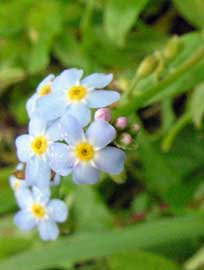
Three species of Forget-me-not flourish in wet places: Myosotis secunda, M. scorpioides and M. laxa (Creeping, Water and Tufted.) They are easily confused and many Flora, including the Atlas 2000, carry a rider to this effect. To complicate things further, the last two hybridise as M x suzae which is partially fertile giving rise to hybrid complexes.
Here are the principal points to look for:
M. secunda has very stiff, almost hispid, patent hairs in the lower part of the stem and styles shorter than calyx tube
M. laxa has appressed hairs on the lower stem and styles shorter than calyx tube
M. scorpioides has styles longer than the calyx tube and often longer than the entire calyx
M. x suzae has very long racemes (to 30+ cms) with small calyces which become brown and shrivelled
Still not sure? The table below might help:
| Character | M. secunda | M.scorpiodes | M.laxa | M. x suzae | Related character |
|---|---|---|---|---|---|
| Spreading hairs on lower stem | Spreading | Spreading | Adpressed | ? | Appressed hairs on lower stem |
| Style longer than calyx tube | Shorter | Longer | Shorter | Equal | Style shorter than calyx tube |
| Raceme | Green to c 20 cm | Green to c 20 cm | Green to c 15 cm | Brown & shrivelled to 30+ cm | |
| Corolla diameter in mm | 6-8 | 8-11 | 4-5 | 5-8 | |
| Stolons present | Yes | Yes | No | Yes | |
| Calyx teeth 0.3 x length of calyx | 0.5 | 0.3 | 0.5 | ? | Calyx teeth 0.5 x length of calyx |
| Calyx teeth lanceolate, narrow based | Lanceolate | Broad | Broad | Broad | Calyx teeth broad based triangular |
| Fruit pedicels short up to 2 x length of calyx | Short | Long | Long | Long | Fruit pedicels long 2.5 – 5 x length of calyx |
| Pollen well formed | Well formed | Well formed | Well formed | Irregular | Pollen irregular in size and shape |
| Seeds usually 2 – 4 | 2 – 4 | 2 – 4 | 2 – 4 | 0-1 | Seeds 0 -1 |